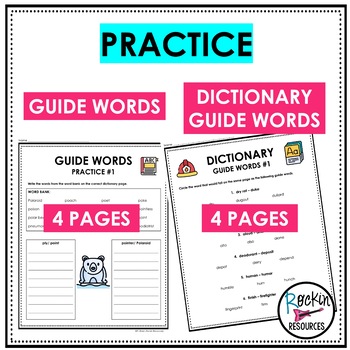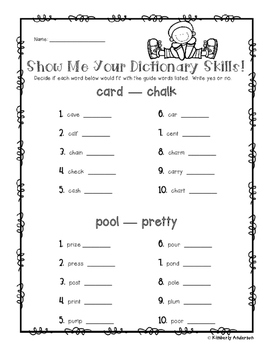The first two words in the analogy (for example, hot: cold) should have the same opposite relationship as the second words in the analogy (for example, happy: sad). Examples of analogies with antonym relationships include: good is to bad as black is to white. Smile is to frown as pretty is to ugly. Dictionary activity Look at the entry words under each pair of guide words. Circle the word in each group that goes with the guide words above. Dangle drop damp deep drawn. Thirsty today toad toddle thirst. Mess model medal mule mock. Use the guide words at the top of each dictionary page; and keep practising until you can find any word within 10 seconds. You should also practise finding words in your own language in your bilingual dictionary. If you use an electronic dictionary, take some time at home to learn how it works and, again, practise finding words quickly.
An analogy compares two things that are mostly different from each other but have some traits in common. By showing a connection between two different things, writers help to explain something important about one thing by using a second thing you already know about. Check out these analogy examples between words and literary concepts.
Simple Word Analogies
Word analogies, or verbal analogies, are like logic puzzles. These compare two different things by breaking them into parts to see how they are related. A word analogy looks like this:
kitten is to cat as puppy is to ____
Sometimes analogies use colons (:) to stand for words, so that when you read it aloud, the analogy looks like:
Kitten : cat :: puppy : _____.
Usually, the last word in the analogy is blank. You need to figure out what the relationship is. In this case, the relationship between a kitten and a cat is a young and adult animal, so you can complete the analogy like this:
kitten is to cat as puppy is to dog
Analogies can show many different types of word relationships. The key is deciding what the relationship between the first set of words is, and matching it in the second set.

Synonym Relationships
Synonym relationships are words that mean the same thing. If the first two words in the analogy are synonyms, then the second set of words have to be synonyms as well. Take a look at these analogies with synonym relationships:
- friendly is to kind as mean is to aggressive
- rough is to scratchy as smooth is to silky
- delicious is to yummy as gross is to yucky
- adorable is to cute as scary is to creepy
Antonym Relationships
Analogies that show antonyms are opposites. The first two words in the analogy (for example, hot : cold) should have the same opposite relationship as the second words in the analogy (for example, happy : sad). Examples of analogies with antonym relationships include:
- good is to bad as black is to white
- smile is to frown as pretty is to ugly
- near is to far as open is to closed
- strong is to weak as love is to hate
Part to Whole
The analogy relationships get trickier when you get past synonyms and antonyms, where word order doesn't matter. Word order matters in a part to whole relationship, in which the first word is a part of something, and the second word is the whole thing. For example:
- feather is to bird as fur is to dog
- wolf is to pack as fish is to school
Be careful about word order! The relationship could be whole to part instead, which means that the whole word comes first and the part word comes second.

- hand is to finger as foot is to toe
- class is to student as forest is to tree

Tool to Action
Dictionary Guide Word Examples For Third Grade Worksheets
Sometimes an analogy relationship lists a tool to the action it performs. In these cases, the order will go noun, verb, noun, verb. Examples of tool and action relationships include:
- pencil is to write as scissors is to cut
- kitchen is to cook as bedroom is to sleep
Notice that changing the word order to action to tool makes it verb, noun, verb, noun.
- hit is to baseball bat as catch is to baseball glove
- print is to printer as copy is to copier
Person to Action
Similar to tool and action relationships are person to action relationships. These analogies include a person rather than an object who performs the action. For example:
- artist is to draw as movie star is to act
- teacher is to instruct as accountant is to count
If you switch the relationship to action to person, you get a different analogy.
- hunt is to hunter as dive is to scuba diver
- bake is to baker as clean is to cleaner
Category to Example
Category to example is similar to whole to part. It lists a category of items first and then an example of that category second. Examples of category to example analogies include:
- cow is to mammal as snake is to reptile
- apple is to fruit as carrot is to vegetable
Watch out for that word order! Example to category relationships result in different types of analogies.
- Peru is to country as South America is to continent
- Pacific is to ocean as Colorado is to river
Cause to Effect
Cause to effect relationships can be nouns or verbs. However, they need to be the exact same relationship on both sides of the analogy. For example:
- eat is to fed as sleep is to rested
- study is to pass as don't study is to fail
Again, try reversing these relationships to see how effect and cause analogies can be tricky.

- flood is to rain as drought is to heat
- wealthy is to invest as broke is to overspend
Intensity Relationships
Relationships of intensity are another type of analogy where word order matters. They involve one word of a lower intensity than the second word, such as:
Word Examples Above
- gray is to black as pink is to red
- giggle is to laugh as sniffle is to sob
Intensity relationships can also decrease in intensity.
- furious is to annoyed as overjoyed is to pleased
- cold is to cool as hot is to warm
Noun to Adjective
You may also see analogies that feature nouns and words that describe them. These noun to adjective relationships include:
- oven is to hot as refrigerator is to cold
- pillow is to soft as rock is to hard
At first glance, you may think these relationships are antonyms. But a closer look at each word pair shows their descriptive relationship, even when you reverse them to adjective to noun:
Guide Words 3rd Grade
- blue is to sky as green is to grass
- wet is to water as dry is to sand
Making a Literary Analogy
You'll often find analogies in literature when the author is comparing two seemingly unlike things. Other literary devices, including metaphors and similes, do the same thing — but they do it a little differently.

The main difference between analogies, metaphors and similes is that metaphors and similes are figures of speech, while literary analogies are a more complex type of argument. Analogies often use similes and metaphors, but their goal is to draw comparisons between two different situations.
Creating Connections
While word analogies aren't often used in writing, the skill of making good comparisons and connections will help you better organize and explain your thoughts. You might find it helpful to describe an idea by explaining what it reminds you of. For more information on this topic, take a look at analogy examples. Or if you'd like to see literary analogies in action, check out 13 analogy examples in literature.
M.Ed. Education